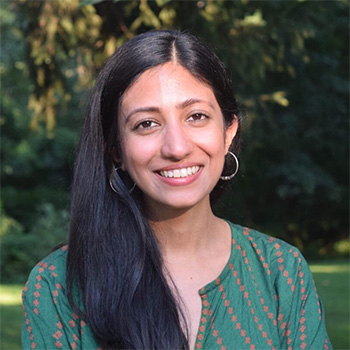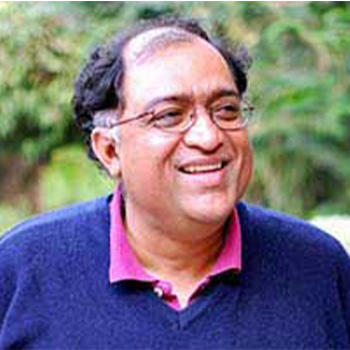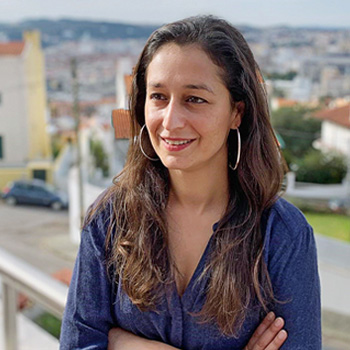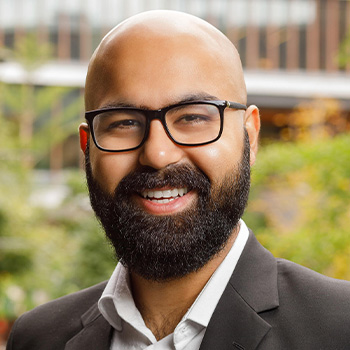Priority Theme Spotlight: Sarah Khan, Ali Cheema, Shandana Khan Mohmand, Asad Liaqat, and Aurat Foundation
Author: Ayuko Picot
Theme: Democracy, Conflict, & Polarization
In today’s Priority Theme Spotlight, we feature EGAP members Sarah Khan (Yale University) and Ali Cheema (Lahore University of Management Sciences) along with their co-authors, Shandana Khan Mohmand (Institute of Development Studies, United Kingdom) and Asad Liaqat (Independent Researcher). We asked them about their paper, “Canvassing the Gatekeepers: A Field Experiment to Increase Women Voters’ Turnout in Pakistan,” published in the American Political Science Review. We also spoke with Mumtaz Mughal, Director of Programmes, at Aurat Foundation.
The study examines the effects of a nonpartisan canvassing campaign conducted by two civil society organizations, Aurat Foundation and South Asia Partnership-Pakistan, on women’s turnout in the 2018 national election in Pakistan. The intervention involved male canvassers approaching men in households (and female canvasser approaching women in households) with informational and motivational material about voting in the upcoming election. During the canvassing visit, men, who are considered ‘gatekeepers’ in Pakistan, were shown videos that depict a male family member being supportive of women voting and taking an active role in politics.
The research team finds that targeting male household members with a canvassing visit emphasizing the importance of women’s participation substantially increased turnout rates of women living in those households. Two months after the intervention, in households where both men and women were canvassed, men were more likely to discuss politics with women in the household and express support for women’s role in democracy. We asked the research team and Mumtaz from Aurat Foundation about their intervention and findings from the project.
In your project on increasing women’s electoral participation in Pakistan, you chose to target men (and women) as opposed to exclusively women. Can you explain why you selected this approach? How do you define the term ‘gatekeeper,’ and how are men considered ‘gatekeepers’ in the context of Pakistan?
Sarah Khan, Ali Cheema, Shandana Khan Mohmand, and Asad Liaqat: Gender and politics scholars have used the term “male gatekeeper” to characterize elite actors who exercise some level of control over women’s political participation, for instance party leaders who control nominations, or bureaucrats who control access to rights and services. We see our project’s conceptual contribution as centering the household as a site for understanding electoral participation, and highlighting how male household members (spouses, fathers, and brothers) also routinely act as gatekeepers of women’s participation in Pakistan, and other patriarchal settings.
Using baseline surveys and interviews we document male gatekeeping at the household level as involving a spectrum of practices, ranging from men restricting women from participation in certain activities through explicit denial of permission, to implicit control over women’s participation through control over the means and resources required for participation. In the case of voting, we do not see a pattern of men denying permission in our sample. However voting requires traveling to the polling location, and men overwhelmingly own the private means of transport. Moreover, concerns of safety and social norms also make it difficult for women to walk or take public transport on their own. In this status quo, women are dependent on men to enable participation.
The practical implication is that when women cannot act autonomously of their male household members, merely targeting them with informational and motivational interventions may be insufficient to increase their participation.
This project was a result of a collaboration between the research team and two civil society organizations. Mumtaz, how and why did Aurat Foundation establish the partnership with the research team?
Mumtaz Mughal: AF was already working on low female turnout in elections when this research team from the Institute of Development and Economic Alternatives (IDEAS) approached us to collaborate on a project that focused on women voters’ turnout in urban areas. The research team valued our experience and work in this area and wanted to incorporate our best practices into their research project. These best practices included a mock voting exercise (to educate voters on the voting process in order to minimize the number of votes discarded), and disseminating information using material developed in AF’s Information Network Centers (INCs).
To provide a brief background, Aurat Foundation (AF) was founded in Pakistan in 1986 with the aim of working on the following three thematic areas: women’s political participation, women’s economic empowerment, and ending violence against women. Since its inception, AF has worked with major political parties, elected representatives and citizens in Pakistan to increase awareness about women’s political rights and responsiveness to women’s needs. AF also set up a national secretariat to ensure that the reserved seats for women were filled after a quota system was introduced for the local government elections of 2000. AF ran a nationwide mobilization campaign to encourage female candidates to participate in local government elections. AF has also been working on the gender gap in voting and candidacy at all levels of elected office. This has included advocating for making gender-disaggregated voting data public, so that the gap can be accurately measured. This long-standing demand was met during the last elections, and gender-disaggregated turnout data from the 2018 Pakistan General Election is publicly available.
Our partnership with IDEAS was helpful because they tested and analyzed our best practices using data. We were also able to compare turnout results in areas where these interventions were implemented and where they were not. Their analysis showed when our mobilization efforts could lead to improvement in turnout rates.
You implemented a nonpartisan, door-to-door voter canvassing campaign in Lahore, Pakistan to increase women voters turnout in the 2018 national election. How did you select this intervention, and how did the intervention work?
SK, AC, SKM, and AL: Door to door canvassing is an increasingly common party outreach strategy in urban areas of Pakistan. However, while shadowing a by-election campaign in Lahore, we found that party workers involved in campaigning often overlooked speaking to women in households. This is backed up by a substantial gender gap in reported contact with party workers and candidates at election time in our baseline survey data, and women’s self-described sense of “invisibility” to parties in focus group discussions. On the other hand, we documented that most civil society organization and NGO efforts to mobilize women voters in past elections took a community level approach, e.g. holding collective informational meetings targeted to women at a central location. While partys’ door-to-door approach targeted to men excludes women, a community level approach potentially excludes the most politically inactive women who are unlikely to attend such meetings, and does not address household level constraints that could prevent women from attending. The intervention in our study tries to correct for the exclusion in existing approaches.
The design is a familiar door-to-door canvassing intervention, but focuses explicitly on women’s participation. In one arm of the study, non-partisan female canvassers directly approach women in households with informational and motivational material (a short video, a mock ballot activity and informational brochure) about voting in the upcoming election. In a second arm, male canvassers approach men in households with similar material, focused on the importance of women’s participation. Importantly, the video shown as part of the canvassing visit depicts a male family member being supportive of women voting and taking an active role in politics, thus modeling the kind of enabling behavior we are trying to encourage among men.
What were some obstacles in implementing this canvassing intervention? How did Aurat Foundation apply its previous experience conducting voter education campaigns to this intervention?
MM: One of the main obstacles in such interventions is getting government approvals which are very important as without them we cannot do any research or survey work. Since AF had a good working relationship with the Election Commission Pakistan (ECP) and other government departments, we were able to get the required approvals, which ensured that we did not face resistance from the community.
Another problem we were aware of given our past experience was that people think they know how to cast votes. However, when we tested women and men on whether they were aware of the process, they realized they did not. Therefore, the material we had developed on voter education, including mock exercises and the training we had provided to our staff, played an important role.
Finally, approaching and talking to women is difficult in many settings, and there is often resistance to this. This problem is more prevalent in urban areas than in rural areas. To deal with this, our team would first engage with men in the community to brief them about our work and gain their confidence. The more the team is sensitized and trained, the fewer problems they will face in the field.
What do your findings reveal about the potential of short-term informational interventions to increase women’s political participation?
SK, AC, SKM, and AL: In our paper, we acknowledge the limitations of short term interventions to challenge the status quo of patriarchal power relations that inhibit women’s participation in public life and politics. Our question is a more modest one: taking these structural inequalities as given, how can interventions be designed to achieve change at the margins?
We see our findings as evidence of the broad point that even change at the margins requires a consideration of power relations. Recognizing that women were limited in their independent agency for taking political action in our context led us to a simple redesign in targeting strategy. Targeting male household members with a canvassing visit emphasizing the importance of women’s participation led to substantially large gains in the turnout rates of women living in those households; such gains were not seen when only women were targeted. A number of canvassing experiments vary the message or the mode of canvassing, to our knowledge ours is the first to test and demonstrate the importance of targeting within the household.
Mumtaz, were the findings from this project that canvassing women is insufficient in increasing women’s voter turnout consistent with findings from your previous projects?
MM: That is true. This has been our experience in the past as well when we were campaigning for women candidates as councilors. Our first step was to engage the men in the households; with men’s engagement we found more women being engaged as well. The issue of mobility for women voters is also mitigated by engaging men and educating them to bring women along when they go to cast votes. We have also noticed that where there are combined polling stations (to allow women to go to the same polling stations as men) the turnout is higher, so we are going to suggest increasing the number of combined polling stations for the upcoming elections.
Two months after the intervention, in households where both men and women were canvassed, men were more likely to accept a sticker expressing support for women’s role in democracy. You also find more political discussion between men and women in households where both were canvassed. What explains these differences?
SK, AC, SKM, and AL: We are intrigued and encouraged by these findings of long term effects from a 20-minute canvassing visit that persist months after the intervention. Since we do not directly observe the process of change, it is hard to speculate on exactly what drives these differences. What we can say is that this is evidence of interaction effects. Canvassing both men and women in the same household (albeit as part of separate visits) seems to quite literally produce interactions in the form of political discussion, and leads to men being willing to take actions in support of women’s political participation down the line. It is worth noting that baseline attitudes towards women voting in our sample were quite positive among both men and women (over 90% of respondents agreed it was appropriate for women to vote). For an action where there is greater disagreement – for example women’s participation in public rallies or women standing as candidates for public office – induced discussion between household members could instead produce conflict and serve to dampen rather than amplify the positive effects of a similar intervention.
In your paper you write, “Our findings also provide policy lessons for closing gender gaps in participation in settings where we might think change is especially difficult.” What are some policy recommendations you propose based on your findings?
SK, AC, SKM, and AL: We propose moving beyond analyses and interventions that treat women as individuals, and considering the power relationships they are embedded in early on in the design process. Short term interventions may not be able to fundamentally alter these unequal relationships in a meaningful way, but ignoring them altogether in policy design is a recipe for ineffectiveness at best, and backlash at worst. Even within unequal structures, there is room for change at the margins.
We do want to be careful to caveat the generalizability of our findings. It is important to remember that the nature and extent of male gatekeeping will likely differ across settings, but even across different actions in the same settings. In the paper we quote Naila Kabeer as a cautionary note on thinking of even strongly patriarchal settings as monolithically unequal: “few cultures operate with starkly dichotomous distributions of power with men making all the decisions and women making none” (Kabeer, 1999). The takeaway is thus not simply that involving men is necessary and sufficient to close gender gaps in political participation. Rather, intervention design should involve identifying whether male gatekeeping is a concern, what form it takes, and whether a short term intervention is likely to be successful. We provide a simple framework for thinking about the potential for change in the paper which we hope can be broadly useful for policy design:
Some of you will continue to collaborate with Aurat Foundation on a coordinated research project on women’s political participation as part of EGAP’s Metaketa Initiative V on Women’s Action Committees and Local Services. How will the findings from this project contribute to your upcoming field experiment on the impacts of trainings delivered to women’s action committees (WACs) in Pakistan?
MM: For the upcoming project, AF will be working with the IDEAs research team to conduct general information meetings and training for women across 90 union councils in Lahore to increase women’s political participation. Our work will involve recruiting women from these areas to join women’s collectives and attend group meetings, designing training materials, and conducting training for a portion of these collectives.
Our ultimate goal is to increase women’s political participation and ensure that women are involved in governance. The Metaketa initiative will help further strengthen our outreach and network in these areas. Through this project itself, we will be interacting with and mobilizing 3,600 women in Lahore and training them to actively work with the government to improve local services. Among these women, we will also find our future activists.
SK, AC, SKM, and AL: One of the big things we are expanding on is thinking beyond levels of participation, e.g. turnout rates, to think about the content and quality of participation. In MK-V, we will study whether collective efficacy training delivered to women’s groups can encourage the formation of collective interests, and engender participation that is then reflective of these interests? While the groups will be all-women, engaging with men as part of the recruitment process is something our partner sees as necessary given our context of male gatekeeping. Male household members’ acceptance of women’s attendance at these groups will not just be necessary to the success of the intervention, but more importantly ensuring that women can participate safely without the risk of facing retributive actions or violence at home. Once again, taking gatekeepers on board is key.
What are some key takeaways from this intervention that you plan to apply to the upcoming Metaketa Initiative project?
MM: Developing and digitizing the information and educational material from the previous project proved to be very effective, and that is something we would like to continue doing in this project as well. Using visualizations on informational material and using a variety of methods of dissemination such as posters, pamphlets, videos is also important when designing new programs. Lastly, in the previous project, we learned that asking women to highlight issues they are presently facing in their communities is an effective starting point to get them engaged and interested in political participation. Learning about their concerns also informs our own policy advocacy work with stakeholders. We would like to incorporate all of this learning in the upcoming project.




